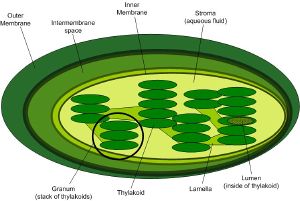Difference between revisions of "Chloroplast" - New World Encyclopedia
Katya Swarts (talk | contribs) m (Choloroplast moved to Chloroplast: Spelling mistake) |
m ({{Contracted}}) |
||
| Line 1: | Line 1: | ||
| − | + | {{Contracted}} | |
'''Chloroplasts''' are [[organelle]]s found in [[plant]] [[cell (biology)|cells]] and [[eukaryote|eukaryotic]] [[alga]]e that conduct [[photosynthesis]]. Chloroplasts capture [[light]] [[energy]] from the [[sun]] to produce the [[free energy]] stored in [[Adenosine triphosphate|ATP]] and [[NADPH]] through a process called [[photosynthesis]]. | '''Chloroplasts''' are [[organelle]]s found in [[plant]] [[cell (biology)|cells]] and [[eukaryote|eukaryotic]] [[alga]]e that conduct [[photosynthesis]]. Chloroplasts capture [[light]] [[energy]] from the [[sun]] to produce the [[free energy]] stored in [[Adenosine triphosphate|ATP]] and [[NADPH]] through a process called [[photosynthesis]]. | ||
Revision as of 18:32, 19 October 2006
Chloroplasts are organelles found in plant cells and eukaryotic algae that conduct photosynthesis. Chloroplasts capture light energy from the sun to produce the free energy stored in ATP and NADPH through a process called photosynthesis.
Origins
Chloroplasts are one of the forms a plastid may take, and are generally considered to have originated as endosymbiotic cyanobacteria. In this respect they are similar to mitochondria, but are found only in plants and protista. Both organelles are surrounded by a double celled composite membrane with an intermembrane space; both have their own DNA and are involved in energy metabolism; and both have reticulations, or many infoldings, filling their inner spaces.
In green plants chloroplasts are surrounded by two lipid-bilayer membranes. The inner membrane is now thought to correspond to the outer membrane of the ancestral cyanobacterium. The chloroplast genome is considerably reduced compared to that of free-living cyanobacteria, but the parts that are still present show clear similarities. Many of the missing genes are encoded in the nuclear genome of the host.
It is interesting to note that in some algae (such as the heterokonts and other protists such as Euglenozoa and Cercozoa), chloroplasts seem to have arisen through a secondary event of endosymbiosis, in which a eukaryotic cell engulfed a second eukaryotic cell containing chloroplasts, forming chloroplasts with three or four membrane layers. In some cases, such secondary endosymbionts have themselves been engulfed by still other eukaryotes, forming tertiary endosymbionts.
Structure
Chloroplasts are flat discs usually 2-10 micrometer in diameter and 1 micrometer thick. The chloroplast has a two membrane envelope termed the Inner & Outer membrane respectively. Between these two layers is the Intermembrane space.
The fluid within the chloroplast is called the stroma, corresponding to the cytoplasm of the bacterium, and contains tiny circular DNA and ribosomes, though most of their proteins are encoded by genes contained in the cell nucleus, with the protein products trafficked to the chloroplast.
Within the stroma are stacks of thylakoids, the sub-organelles where photosynthesis actually takes place. A stack of thylakoids is called a granum. A thylakoid looks like a flattened disk, and inside is an empty area called the thylakoid space or lumen. The photosynthesis reaction takes place on the membrane of the thylakoid, and, as is also the case with mitochondria, involves the coupling of cross-membrane fluxes with biosynthesis.
See also
- Chloroplast membrane
- Inner membrane
- Outer membrane
ReferencesISBN links support NWE through referral fees
- This article contains material from the Science Primer published by the NCBI, which, as a US government publication, is in the public domain at http://www.ncbi.nlm.nih.gov/About/disclaimer.html.
External links
- Chloroplasts and Photosynthesis: The Role of Light from Kimball's Biology Pages
- Chloroplast, Botany
- Use of chloroplast DNA in studying plant phylogeny and evolution
| Organelles of the cell |
|---|
| Acrosome | Chloroplast | Cilium/Flagellum | Centriole | Endoplasmic reticulum | Golgi apparatus | Lysosome | Melanosome | Mitochondrion | Myofibril | Nucleus | Parenthesome | Peroxisome | Plastid | Ribosome | Vacuole | Vesicle |
Credits
New World Encyclopedia writers and editors rewrote and completed the Wikipedia article in accordance with New World Encyclopedia standards. This article abides by terms of the Creative Commons CC-by-sa 3.0 License (CC-by-sa), which may be used and disseminated with proper attribution. Credit is due under the terms of this license that can reference both the New World Encyclopedia contributors and the selfless volunteer contributors of the Wikimedia Foundation. To cite this article click here for a list of acceptable citing formats.The history of earlier contributions by wikipedians is accessible to researchers here:
The history of this article since it was imported to New World Encyclopedia:
Note: Some restrictions may apply to use of individual images which are separately licensed.
